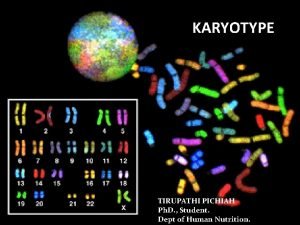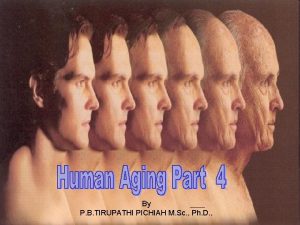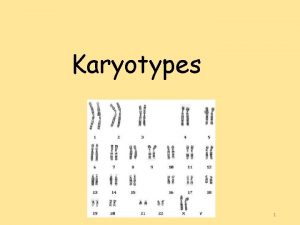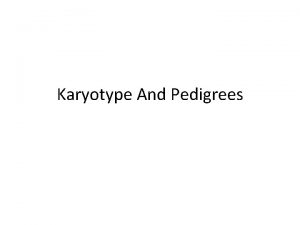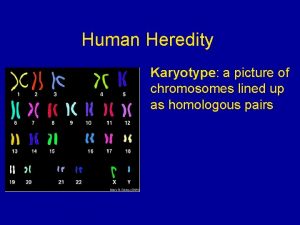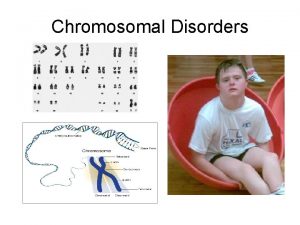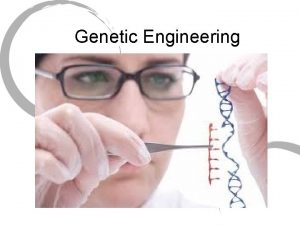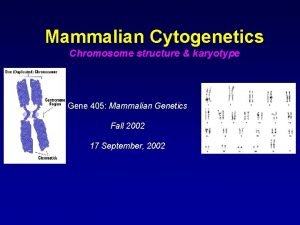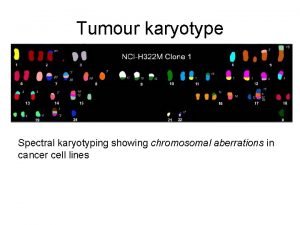KARYOTYPE TIRUPATHI PICHIAH Ph D Student Dept of















- Slides: 15

KARYOTYPE TIRUPATHI PICHIAH Ph. D. , Student. Dept of Human Nutrition.

Chromosomes Rod shaped structures found in the center of the nucleus of every cell in the body (except RBC). Each sperm and each ovum contains 23 chromosomes. The chromosomes contain the DNA and genes. The fertilized egg (zygote) and all the body cells that develop from it (except the sperm cells and the ova) contain 46 chromosomes. 22 of the pairs are called autosomes and are numbered from largest to smallest. The autosomes are not involved in determining sex. The 23 rd pair are the sex chromosomes: XX in females XY in males (1)Chromatid – one of the two identical parts of the chromosome after S phase. (2) Centromere – the point where the two chromatids touch, and where the microtubules attach. (3) Short arm. (4) Long arm.

INTRODUCTION �A karyotype test is basically a test that analyzes our chromosomes. �It tells you how many chromosomes a person has and looks at the structure of each chromosome individually. �A karyotype can be performed on any tissue but most often it is done from a blood sample, a sample of amniotic fluid or a piece of placenta obtained through chorionic villi sampling. �Karyotyping is a complex process that involves growing the cells, obtaining the chromosomes, staining the chromosomes, analyzing the chromosomes and reporting the results.

DEFINITION �A laboratory test used to study an individual's chromosome make-up. Chromosomes are separated from cells, stained, and arranged in order from largest to smallest so that their number and structure can be studied under a microscope.

History of karyotype studies � Chromosomes were first observed in plant cells by Karl Wilhelm von Nägeli in 1842. � Their behavior in animal (salamander) cells was described by Walther Flemming, the discoverer of mitosis, in 1882. � The name was coined by another German anatomist, von Waldeyer in 1888. � Investigation into the human karyotype took many years to settle the most basic question: how many chromosomes does a normal diploid human cell contain? � In 1912, Hans von Winiwarter reported 47 chromosomes in spermatogonia and 48 in oogonia, concluding an XX/XO sex determination mechanism. � Painter in 1922 was not certain whether the diploid number of humans was 46 or 48 latter changed his opinion.

� Culture cells WBC � Pre-treating cells in a hypotonic solution, which swells them and spreads the chromosomes � Arresting mitosis in metaphase by a solution of colchicine � Squashing the preparation on the slide forcing the chromosomes into a single plane � � Dying by Giemsa � Cutting up a photomicrograph and arranging the result into an indisputable karyogram.


Types of banding G-banding : yields a series of lightly and darkly stained bands - the dark regions tend to be heterochromatic, late-replicating and AT rich. The light r egions tend to be euchromatic, early- replicating and GC rich. R-banding : reverse of G-banding , dark regions are euchromatic (GC) and light is heterocromatin (AT). C-banding: constitutive heterochromatin. Q-banding : Fluorescent pattern obtained using quinacrine for staining same as Gimsa. T-banding: visualize telomeres.

TYPES OF KARYOTYPING The types of karyotyping are: Multicolor Karyotyping (Spectral and Color Changing Karyotyping) : Multicolor karyotyping identifies all chromosomes in a metaphase preparation based on their color differences. Fluorescence in Situ Hybridization (FISH) : Uses fluoresce dye to colour genes useful for gene mapping and for identifying chromosomal abnormalities Comparative Genomic Hybridization (CGH). : analysis of regional changes in the DNA content of tumor cells.

Chromosome abnormalities Turner syndrome : Results from a single X chromosome (45, X or 45, X 0). Klinefelter syndrome : The most common male chromosomal disease, otherwise known as 47, XXY is caused by an extra X chromosome. Edwards syndrome : is caused by trisomy (three copies) of chromosome 18. Down syndrome, a common chromosomal disease, is caused by trisomy of chromosome 21. Patau syndrome : is caused by trisomy of chromosome 13.

Observations Six different characteristics of karyotypes are usually observed and compared: Differences in absolute sizes of chromosomes. Differences in the position of centromeres. This is brought about by translocations. Differences in relative size of chromosomes can only be caused by segmental interchange of unequal lengths. Differences in basic number of chromosomes. Differences in number and position of satellites, Differences in degree and distribution of heterochromatic regions.

Variation is often found: Between the sexes Between the germ-line and soma (between gametes and the rest of the body) Between members of a population (chromosome polymorphism) Geographical variation between races Mosaics or otherwise abnormal individuals

SPECTRAL KARYOTYPING

Prenatal diagnosis: amniocentesis • sampling cells from amniotic fluid • usually done ~ 15 -18 weeks

Thank for your attention. 15
 Different types of karyotypes
Different types of karyotypes Gome dept
Gome dept Dept ind onegov
Dept ind onegov Rowan county dept of social services
Rowan county dept of social services Dept. name of organization (of affiliation)
Dept. name of organization (of affiliation) Fire dept interview questions
Fire dept interview questions Employment first ohio
Employment first ohio Oxford dept of continuing education
Oxford dept of continuing education Nys dept of homeland security
Nys dept of homeland security Department of agriculture consumer services
Department of agriculture consumer services Florida dept of agriculture and consumer services
Florida dept of agriculture and consumer services Gome dept
Gome dept Albany county department of social services
Albany county department of social services Dept of education
Dept of education Mn dept of education
Mn dept of education Oviposition
Oviposition
